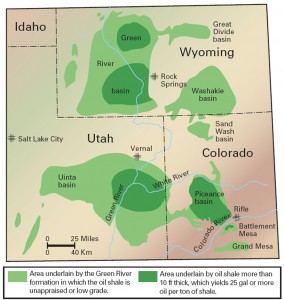Seven conservation groups have notified the Bureau of Land Management they plan to sue the agency for making more than 1,200 square miles available for potential oil shale and tar sands leasing in Colorado, Utah and Wyoming.
The conservation groups claimed in a formal lawsuit notice filed last week that the BLM violated the Endangered Species Act by not formally consulting with the U.S. Fish and Wildlife Service.
The notice was filed by the Grand Canyon Trust, Living Rivers, the Southern Utah Wilderness Alliance, Rocky Mountain Wild, the Biodiversity Conservation Alliance, the Center for Biological Diversity and the Sierra Club.
“Strip mining of our public lands will push endangered species closer to extinction,” said Matt Sandler, staff attorney with Rocky Mountain Wild. “BLM should be working with the U.S. Fish and Wildlife Service to conserve species, not furthering their demise on behalf of the fossil fuel industry.”
According to the notice, the BLM acknowledged the decision to allow oil shale and tar sands leasing could affect the Colorado pikeminnow, humpback chub, razorback sucker, Mexican spotted owl and other threatened or endangered species.
“The BLM should be managing these wild areas for the rich wildlife diversity they provide,” said Eric Huber, Sierra Club senior managing attorney.
The BLM has previously indicated it does not consult with Fish and Wildlife until specific plans are in development.
“The BLM felt the endangered species act compliance would happen at the level of an individual mining application, or the leasing out of parcels for oil shale and tar sands,” said John Weisheit, director of Living Rivers. “The attorneys who work on endangered species act said that was egregious, so we made an issue of it.”
The lawsuit notice comes as the BLM debates new rules for oil shale leasing. A public comment period on those proposed rules ended Tuesday May 28, but BLM has said it will provide an extra 30 days for people to submit comments.
The conservation groups said May 28 they want to see stronger oil shale leasing rules that better address health and environmental concerns.
Under the Endangered Species Act, the BLM has 60 days to address the concerns spelled out in the notice to avoid a lawsuit.
In the notice given to the BLM, it states that in order to prevent litigation the BLM must undergo consultation with U.S. Fish and Wildlife Service and refrain from making any commitment of site-specific leasing until completing consultation.
The State of Utah is now leasing 32,000 acres to U.S. Oil Sands in the PR Springs Area within the Books Cliffs, on the border of Uintah and Grand counties north of Moab. U.S. Oil Sands, a Canadian company, plans to have a strip tars sand mining operation up and running by the second quarter of 2014, said Barclay Cuthbert, president of operations for U.S. Oil Sands.
A public land exchange between BLM and Utah School and Institutional Trust Lands Administration (SITLA) may double the amount of state land available for tar sands mining.
“Of the lands that would be exchanged from BLM to the State of Utah, 31,429 acres have been determined to have potential for tar sands,” said Lisa Bryant, assistant field manager of the Moab BLM Office.
Bill Hedden, executive director of the Grand Canyon Trust, helped negotiate the land exchange to protect iconic recreational areas in Grand County, such Corona Arch, Morning Glory Arch and the Colorado River Corridor.
“We worked very closely to design the exchange. We feel very good about the lands to be protected,” Hedden said.
But, he said, when the land exchange was first proposed in 2009, potential for tar sands development was considered a remote possibility.
“We all realize that when you do an exchange, that SITLA will develop the land one way or another. If it is conventional oil and gas, that is less of a concern,” Hedden said. “Now with the (tar sands mining) expertise being developed in Alberta, they may figure out extractive technology they could use here in Utah. It is more of a concern.”
Strip mining of our public lands will push endangered species closer to extinction.”




